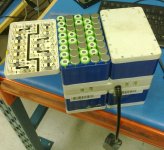>> SELL THREAD <<
I am looking into using 18650 cells for some time now: link 1, link 2, link 3, link 4 (please use google translate for these). Results are stunning: 18650 cells, even with air gaps between them, offer TWICE higher capacity for volume and weight, compared to A123 20Ah pouch cells. And cheaper, too.
So after all that, probably there is no doubt that this is the way to go. However there is one major flaw: assembly complexity. This prevents 18650 from being used in hobby projects...
So here comes my project in.
Pack's configuration is 12s6p. Reasons are pretty simple:
* 48V power supplies (MeanWell for example) can be adjusted up by +10%, which gives us 52.8V. LG D1 cells are 4.35V, which gives us 52.2V in 12s configuration.
* Single cell is around 10Wh, which gives us 720Wh total capacity in 12s6p configuration. I think this is an average need of more serious ebiker.
Features
* Spot-welding
* low part count
* cell-level fuses with adjustable trip current (prevents fires in case of external or internal short)
* fuses on balancing wires (prevents fires due to shorted balancing wires or BMS)
* thermal management-ready (forced air channels)
* possibility to replace one cell without taking apart whole pack
* small size and weight
More details on assembly and single cell replacement procedures can be found on my blog (you will need google translation):
http://e-motion.lt/2013/12/12/akumuliatoriaus-blokas-is-18650-cilindriniu-celiu/
I am looking into using 18650 cells for some time now: link 1, link 2, link 3, link 4 (please use google translate for these). Results are stunning: 18650 cells, even with air gaps between them, offer TWICE higher capacity for volume and weight, compared to A123 20Ah pouch cells. And cheaper, too.
So after all that, probably there is no doubt that this is the way to go. However there is one major flaw: assembly complexity. This prevents 18650 from being used in hobby projects...
So here comes my project in.
Pack's configuration is 12s6p. Reasons are pretty simple:
* 48V power supplies (MeanWell for example) can be adjusted up by +10%, which gives us 52.8V. LG D1 cells are 4.35V, which gives us 52.2V in 12s configuration.
* Single cell is around 10Wh, which gives us 720Wh total capacity in 12s6p configuration. I think this is an average need of more serious ebiker.
Features
* Spot-welding
* low part count
* cell-level fuses with adjustable trip current (prevents fires in case of external or internal short)
* fuses on balancing wires (prevents fires due to shorted balancing wires or BMS)
* thermal management-ready (forced air channels)
* possibility to replace one cell without taking apart whole pack
* small size and weight
More details on assembly and single cell replacement procedures can be found on my blog (you will need google translation):
http://e-motion.lt/2013/12/12/akumuliatoriaus-blokas-is-18650-cilindriniu-celiu/




